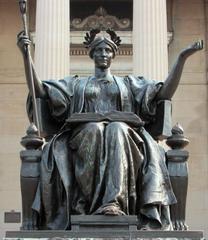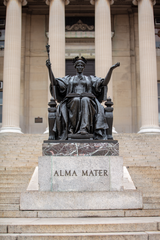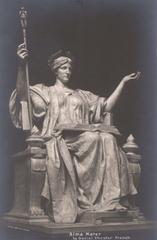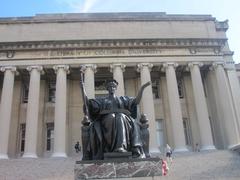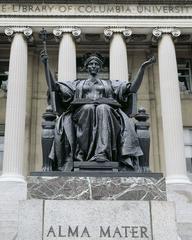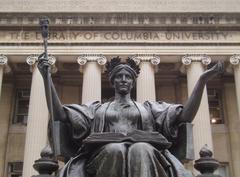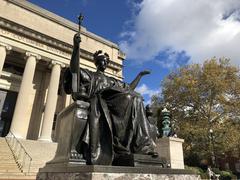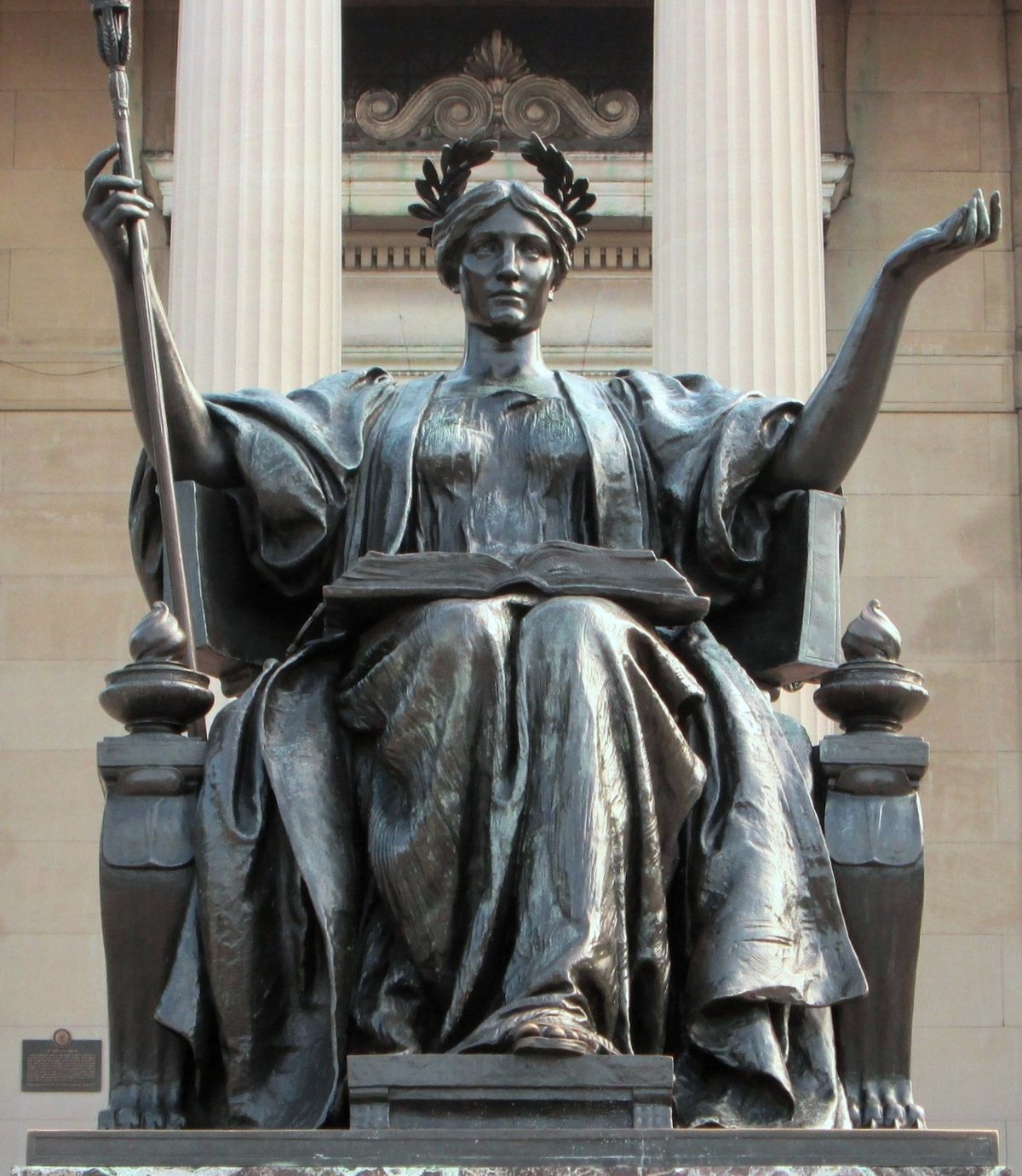
Alma Mater Visiting Hours, Tickets, and Guide to New York City’s Historic Columbia University Site
Date: 14/06/2025
Introduction
The Alma Mater statue, majestically poised on the steps of Low Memorial Library at Columbia University’s Morningside Heights campus, stands as a powerful symbol of academic tradition, wisdom, and the nurturing spirit of higher education. Sculpted by Daniel Chester French and unveiled in 1903, this iconic bronze monument embodies the university’s commitment to fostering knowledge and virtue. As a centerpiece among New York City’s historical sites, Alma Mater welcomes students, alumni, art lovers, and curious visitors alike. This comprehensive guide explores the statue’s history, artistry, symbolism—including the famous hidden owl—its cultural impact, and practical visitor information to ensure a rewarding experience at this treasured landmark (Columbia University Archives; Bronzes Gallery; Secret Images).
Historical Overview and Artistic Significance
Origins of the Alma Mater Concept
The phrase “Alma Mater,” Latin for “nourishing mother,” traces its roots to the University of Bologna’s motto, “Alma Mater Studiorum.” This concept migrated to America with the founding of King’s College (later Columbia University) in 1754. Samuel Johnson, Columbia’s first president, incorporated the Alma Mater figure into the college seal, signifying the institution’s role as a nurturing guide for students’ intellectual and moral development (Columbia University Archives).
Commissioning and Creation of the Statue
In memory of alumnus Robert Goelet, his widow Harriette W. Goelet commissioned Daniel Chester French—celebrated for the Lincoln Memorial—to create a lasting tribute. French’s design, completed in 1903, was cast in bronze and set atop a marble and granite base designed by McKim, Mead & White, the campus’s renowned architects (yeodoug.com; Secret Images).
Artistic Features and Symbolism
French’s Alma Mater is an 8.6-foot-high, 5.9-foot-wide, and 6.2-foot-deep statue representing Athena, the Greek goddess of wisdom. She sits on a throne with lamps symbolizing wisdom and learning, holds an open book for knowledge, and a scepter topped by King’s College’s crown, referencing Columbia’s royal origins. The hidden owl—a nod to Athena and wisdom—is cleverly tucked into the robe’s folds, inspiring campus traditions and student lore (Bronzes Gallery; Waymarking; Columbia Pre-College Tour).
Cultural Importance and Campus Traditions
Alma Mater as University Emblem
Since its installation, Alma Mater has become a unifying emblem for Columbia, featured in graduation photos, ceremonies, and university branding. It also serves as a gathering spot for reflection and celebration, anchoring collective memory for alumni and visitors (Columbia College Today; Wikipedia).
Site of Protest and Expression
Alma Mater’s prominence has made it a focal point for campus activism. The statue was adorned with protest banners during the 1968 student demonstrations, and in 1970, a bomb damaged its throne amid national unrest. Restoration in 1978 reaffirmed Alma Mater’s resilience and continued relevance as a symbol of free expression (The Clio; Columbia University Archives).
Pranks, Lore, and Student Culture
Alma Mater is embedded in campus lore, from the tradition of seeking the hidden owl for good luck to legendary pranks like the theft and return of her crown and scepter—sometimes by rival Ivy League students (Scouting NY; Columbia University Archives; The Clio).
Restoration and Preservation
Over its 120-year history, Alma Mater has undergone several restorative efforts. Originally gilded, the statue’s gold finish was re-applied in 1928 and later removed in 1950. A centennial restoration in 2003 addressed both cosmetic and structural needs, preserving the statue for future generations (Secret Images; yeodoug.com).
Visiting Information
Location and Access
- Address: Low Memorial Library steps, Columbia University, 116th Street & Broadway, New York, NY 10027 (Columbia Walking Tour PDF)
- Directions: Subway Line 1 to 116th Street–Columbia University; M4, M5, M11, SBS-M60, and M104 buses serve the area.
Hours and Admission
- Statue Access: Outdoors and accessible year-round during daylight hours. No tickets or fees required.
- Low Memorial Library: Open Monday–Friday, 9:00 a.m.–5:00 p.m.
Accessibility
- Main campus paths and the statue area are wheelchair accessible. Steps may present a challenge, but ramps and elevators are available in nearby buildings. For assistance, contact Disability Services at (212) 854-2388 (Columbia Admissions).
Visitor Center & Resources
- Location: Hepburn Lounge, Uris Hall (Spring 2024), 3022 Broadway.
- Maps: Download self-guided walking tour maps or pick up at the Visitor Center.
Tours and Campus Highlights
- Guided Walking Tours: Led by current students; include Alma Mater and campus highlights. Advance registration required (Columbia Admissions).
- Self-Guided Tours: Maps available online and at Visitor Center.
- Nearby Attractions: Low Memorial Library, St. Paul’s Chapel, College Walk, Butler Library, Riverside Park, Grant’s Tomb, Cathedral of St. John the Divine.
Practical Tips for Visiting
- Best Time: Weekdays 9:00 a.m.–5:00 p.m. for full campus access; mornings or late afternoons for optimal photography.
- Attire: Dress for weather; wear comfortable shoes.
- Photography: The statue and plaza are ideal for photos, especially during “golden hour.”
- Amenities: Public restrooms in Alfred Lerner Hall; cafes on campus and eateries nearby.
- Security: The university provides a safe environment with visible security and emergency call boxes.
FAQ: Alma Mater Statue
Q: What are the visiting hours?
A: The statue is accessible outdoors year-round during daylight hours.
Q: Is there an entry fee or ticket?
A: No, visiting Alma Mater and campus grounds is free.
Q: Are guided tours available?
A: Yes, guided and self-guided tours are available. Check the Columbia Admissions page for schedules.
Q: Is Alma Mater wheelchair accessible?
A: Yes; ramps and accessible paths are available. Contact Disability Services for assistance.
Q: Can I take photos at the statue?
A: Absolutely! Alma Mater is a favorite photo spot.
Plan Your Visit and Explore Further
Alma Mater at Columbia University offers a profound connection to academic tradition, campus life, and New York City’s cultural landscape. Freely accessible, rich in history and symbolism, and surrounded by campus and city attractions, it’s a rewarding destination for every visitor. For a more immersive experience, download the Audiala app for interactive maps and guided tours and follow Columbia University’s official channels for the latest news and events.
References
- Columbia University Archives
- Bronzes Gallery
- Columbia College Today
- Columbia Admissions
- Secret Images
- The Clio
- Columbia Pre-College Tour
- Waymarking
- Scouting NY
- Columbia Walking Tour PDF
